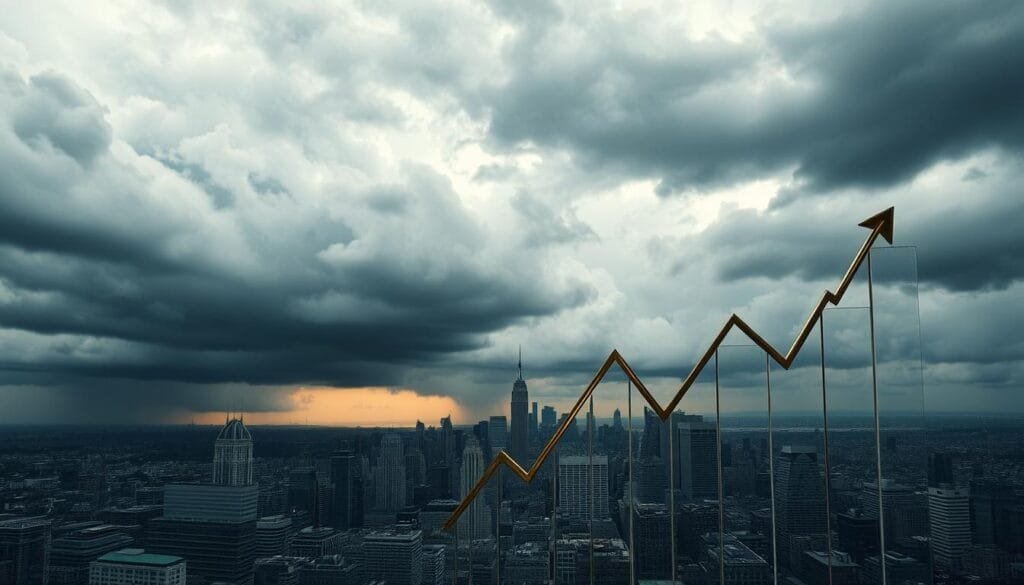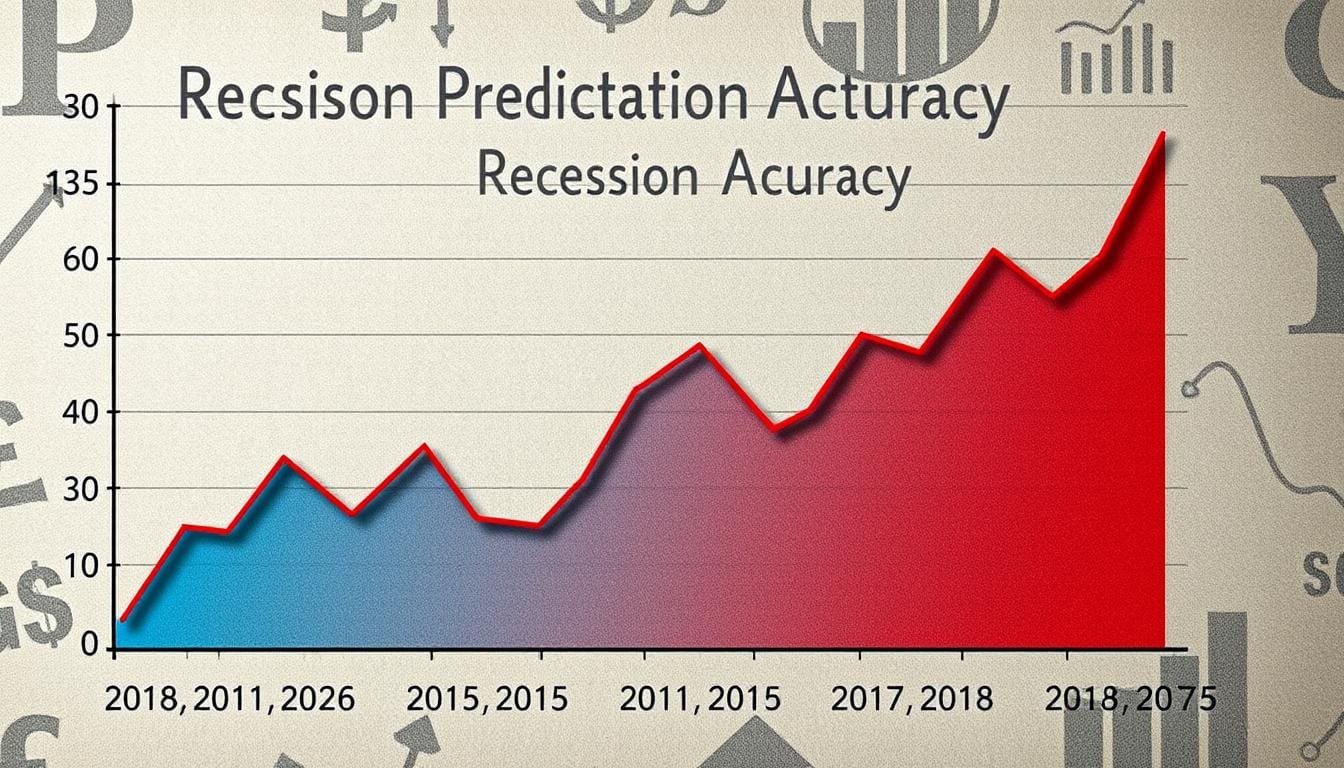Understanding recession forecast accuracy is crucial in economic discussions. The ability to predict short-term economic downturns has improved. However, predicting long-term outcomes remains a challenge. Recent studies, like those by the Federal Reserve Bank, show we can accurately anticipate near-term economic issues.
Yet, precision drops when predicting long-term economic trends. For instance, the Philadelphia Fed survey suggests a 34.4% chance of an upcoming recession. This is significant, considering the Fed’s fight against inflation. These forecasts depend on reading economic indicators accurately, aiming for reliable economic insights.
Key Takeaways
- Short-term recession predictions exhibit improved accuracy, aiding in immediate economic planning.
- The limitations of long-term economic forecasts underscore the inherent unpredictability of market dynamics.
- Crucial economic indicators provide a framework for near-term financial forecasting, acting as a beacon amid fiscal uncertainties.
- Institutional projections, such as those by the Federal Reserve, have become pivotal in shaping our understanding of potential recessions.
- The intricate practice of economic forecasting demands an acceptance of probable miscalculations, emphasizing the necessity for adaptable strategies.
- The fickle nature of economic predictors reinforces the need for continual refinement and technological enhancement in the field of economic analysis.
The Art and Science Behind Economic Forecasting
Economic forecasting mixes art and science. It uses economic forecasting methods and recession prediction models. These tools help experts guess future economic trends by studying past and present data. However, it’s tough to predict exact future economic outcomes.
Understanding the Basics of Economic Forecasting
Economic forecasting uses statistical tools and models. It aims to predict future business cycles and economic conditions. These methods range from simple analyses to complex models that use business cycle indicators. Examples include inflation rates, unemployment figures, and consumer feelings. These different tools try to make economic forecasts more accurate and reliable.
The Role of Economic Indicators in Predicting Recessions
Economic indicators are key to economic forecasting methods. Important ones are GDP growth, employment stats, and how much consumers spend. Big financial firms like Wells Fargo and JPMorgan use these indicators in their recession prediction models. For instance, Wells Fargo predicts a mild recession in 2023. It talks about a possible increase in unemployment, showing how these indicators are important in real life.
Challenges in Accurate Economic Forecasting
Predicting economic downturns accurately remains a challenge. Historically, forecasts have missed 148 out of the last 150 recessions. This shows how unpredictable economies can be, affected by many unexpected global factors. Mark Pearson from the OECD says that global complexities make traditional models less accurate. He emphasizes the need for better approaches.
In conclusion, economic forecasting tries to guess future conditions as accurately as possible. There are many obstacles, but advancements in models and a better grasp of business cycle indicators may improve predictions. It’s a mix of art and science, trying to peek into the economic future.
How Accurate Is Economics at Predicting Recession
When we look at how well economics predicts recessions, there’s a clear pattern of inconsistency. Historical examples show that experts often struggle to forecast downturns accurately.

Given the complexities of global economies, even experienced forecasters miss the mark on long-term predictions. Take the 2001 recession; predictions were far from what actually happened.
| Forecast Year | Expected GDP Growth | Actual GDP Growth |
|---|---|---|
| Q1 2001 | 2.5% | 0.5% |
| Q4 2007 | 2.2% | 0.6% |
These forecasts greatly underestimated the likelihood of recession at these times. This shows the limitations of even the best economic models.
Interestingly, research suggests changes in investor sentiment, like those from an inverted yield curve, can signal downturns. But, there’s still a gap in predicting the exact timing.
- 38% likelihood of a new recession next year, some economists say.
- A 1 in 3 chance of facing a downturn in the next 12 months, recent surveys find.
These statistics underline the difficulty of predicting economic downturns accurately. Despite new modeling techniques, uncertainty is still a big part of economic forecasts. This uncertainty affects everyone from policymakers to the general public.
Analyzing Historical Accuracy of Recession Predictions
In the past, predicting recessions relied on expert opinions. Now, we use data and complex models. This shift has improved our forecasts. We now compare old and new methods to see how accurate our predictions are.
Case Study: The Great Recession Forecast
The Great Recession was a big challenge for forecasters. They used different tools to predict economic trends. One tool, the Treasury yield curve, warned us early. However, the severity and timing of the downturn were unexpected. This shows we need to keep improving our forecasts.
Comparing Predictions and Outcomes Over Decades
Composite indexes have made forecasts better. They put together many economic signals. This has helped detect U.S. recessions earlier. Adding innovations like the BBK Leading Index has made predictions even sharper. This index uses a lot of data to forecast downturns better.

Accuracy Rates of Different Economic Institutions
Different models show varying success rates. The Conference Board Leading Economic Index is one good short-term predictor. It has a high AUC value for accuracy. Other indicators, like the yield curve and BBK index, are also reliable. They can predict recessions months ahead.
Data and tools have made recession forecasting better. But global economies are complex. No one model is perfect. So, using multiple models, regularly checking forecasts, and understanding economics are key. This way, we can make our recession forecasts more reliable.
Impact of Technological Advancements on Forecasting Accuracy
Technology has completely changed economic forecasting. Technological advancements, like big data, AI, and machine learning, have made forecasting more efficient and accurate. They have improved upon the old methods.

Old tools, like econometric models, often fail in complex situations. They lack adaptability and the ability to analyze data in real time.
The Emergence of Big Data Analytics in Economics
Big data economics has solved these problems. It gives a more detailed view of economic patterns and behaviors. Big data analytics works with large, varied data sets to find patterns and correlations quickly and on a large scale. This improves predictions and helps us understand market dynamics better.
AI and Machine Learning: A New Frontier in Economic Forecasting
AI economic forecasting has been changed by machine learning. Techniques like neural networks and deep learning analyze large datasets well. They can automatically process data in real time. They use data from many sources, like social media and real-time financial transactions. This starts a new phase of thorough economic analysis.
Here’s a closer look at how these technologies help in forecasting:
| Technology | Description | Impact on Forecasting Accuracy |
|---|---|---|
| AI & Machine Learning | Advanced algorithms that learn from data, recognize patterns, and make decisions with minimal human intervention. | Enhances precision and speed in economic forecasting by processing vast datasets rapidly. |
| Big Data Analytics | Processes large volumes of unstructured data to uncover hidden patterns, correlations, and market trends. | Improves granularity and timeliness of forecasts; allows for the integration of multiple data sources. |
| Real-time Data Integration | Use of up-to-the-minute data from various sources, contributing to more responsive and current insights. | Enables immediate recalibration of forecasts in response to market changes, reducing lag in prediction adjustments. |
By combining big data economics, AI economic forecasting, and machine learning, we can predict future economic trends better. We can also make these forecasts faster and more accurately.
Conclusion
As we explored the challenge of predicting recessions, we discovered a blend of hope and realism. The mistakes made before the Great Recession show how hard economic forecasting is. Yet, the future holds exciting possibilities, thanks to new tools in predictive analytics and recession forecasting. These advancements could lead to a breakthrough in understanding the economy’s future.
The road ahead offers both opportunities and obstacles. Recent data presents a changing scenario of growth and caution. With the economy showing signs of growth and consumer spending up, the relationship between economic indicators is complex. The potential for recessions remains, highlighting the need for careful monitoring. We must keep analyzing big changes, like the $6.5 trillion injected into the economy during 2020 and 2021, and the increase in household savings.
Our goal is to master the capabilities of AI, Big Data, and various recession forecasting tools. We must move forward wisely, remembering the lessons from the Federal Reserve Bank of New York’s past. Every piece of economic data, from unemployment rates to inflation, helps us see more clearly. As we step into the future of economic forecasting, let’s commit to precision, prepare for surprises, and constantly improve our tools. Let’s aim for a future where economic forecasts are more accurate and reliable than ever before.
FAQ
What determines the accuracy of recession forecast accuracy?
The accuracy of a recession forecast depends on several factors. These include the quality of the economic indicators and the methods used in prediction models. Also, unexpected economic shocks that hit the business cycle can impact forecasts.
How do economic forecasting methods work?
Economic forecasting uses statistical tools and models along with knowledge of how economies work. It analyzes variables and indicators that might influence the economy. Forecasters also take into account unpredictable factors like sudden changes in demand and supply.
What is the role of economic indicators in predicting recessions?
Economic indicators are essential for understanding the economy’s health. They help forecasters see which direction the economy might go. This can give clues about possible recessions or growth phases.
What challenges do forecasters face in making accurate economic predictions?
Forecasters encounter several hurdles in making precise predictions. They must deal with unexpected economic events, the complex interaction between global economies, and the uncertainties in long-term forecasts. These challenges can make it hard to predict economic downturns accurately.
How reliable is economics in forecasting economic downturns?
Economics can be somewhat reliable in predicting downturns, especially in the short term. Predictions for the next quarter are often accurate. However, the further out a forecast goes, the more likely errors become.
How did economic forecasters fare with the Great Recession forecast?
Success in predicting the Great Recession varied among forecasters. Many did not foresee the extent of the downturn. Yet, some institutions, like ITR Economics, managed to predict key recovery milestones. This shows that it’s possible to achieve some accuracy in economic forecasts.
How do different economic institutions compare in their forecasting accuracy?
The accuracy of economic forecasts varies between institutions. For example, ITR Economics had an accuracy rate of 92.19% for forecasts five quarters ahead in 2019. This indicates a wide range of precision among forecasters.
How is Big Data analytics changing the field of economic forecasting?
Big Data analytics brings more in-depth and comprehensive analyses by evaluating large amounts of data. This can improve how we predict business cycles and refine our recession forecasts.
What is the potential impact of AI on economic forecasting?
AI and machine learning are revolutionizing economic forecasting. They offer sophisticated predictive tools that efficiently analyze large data sets. This could make forecasts more accurate by revealing deeper connections between economic indicators.
Looking forward, what is the future of economic forecasting in relation to predicting recessions?
The future of economic forecasting looks promising thanks to new tools like AI. These advancements may lead to more accurate predictions. Yet, it’s important to remember that forecasts always come with a degree of uncertainty.
